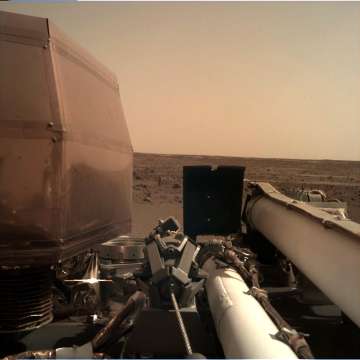NASA's Insight spacecraft successfully lands on Mars after six-month journey
The lander sent signals indicating that its solar panels are open and collecting sunlight on the Martian surface, InSight mission team said in a statement.

NASA's robotic InSight lander -- designed to dig deep into the rocky surface of Mars to reveal its secrets -- has successfully touched down on the Red Planet after a supersonic plunge through its rose-hued atmosphere, the US space agency said Tuesday.
The lander sent signals indicating that its solar panels are open and collecting sunlight on the Martian surface, InSight mission team said in a statement.
"Aaah...soaking up the Sun with my solar panels. After a long flight, and thrilling #MarsLanding, it feels great to get a good stretch and recharge my batteries," the InSight Twitter handle posted.
NASA's Mars Odyssey orbiter relayed the signals of the landing, which were received on Earth at about 5:30 pm PST (7 am IST, Tuesday).
Solar array deployment ensures the spacecraft can recharge its batteries each day. Odyssey also relayed a pair of images showing InSight's landing site.
The Insight lander touched down near Mars' equator on the western side of a flat, smooth expanse of lava called Elysium Planitia, with a signal affirming a completed landing sequence at approximately 3 pm EST (1:30 am IST, Tuesday).
The probe was launched from the Vandenberg Air Force Base in California, US on May 5.
"Today, we successfully landed on Mars for the eighth time in human history," said NASA Administrator Jim Bridenstine.
"InSight will study the interior of Mars, and will teach us valuable science as we prepare to send astronauts to the Moon and later to Mars," said Bridenstine.
The landing signal was relayed to NASA's Jet Propulsion Laboratory (JPL) in California, via one of NASA's two small experimental Mars Cube One (MarCO) CubeSats, which launched on the same rocket as InSight and followed the lander to Mars.
They are the first CubeSats sent into deep space. After successfully carrying out a number of communications and in-flight navigation experiments, the twin MarCOs were set in position to receive transmissions during InSight's entry, descent and landing.
"We hit the Martian atmosphere at 19,800 kilometers per hour, and the whole sequence to touching down on the surface took only six-and-a-half minutes," said InSight project manager Tom Hoffman at JPL.
"During that short span of time, InSight had to autonomously perform dozens of operations and do them flawlessly -- and by all indications that is exactly what our spacecraft did," said Hoffman.
Confirmation of a successful touchdown is not the end of the challenges of landing on the Red Planet, NASA said.
InSight's surface-operations phase began a minute after touchdown. One of its first tasks is to deploy its two decagonal solar arrays, which will provide power. That process begins 16 minutes after landing and takes another 16 minutes to complete.
Verification of whether the panels have been deployed will come from NASA's Odyssey spacecraft, currently orbiting Mars. That signal is expected to reach InSight's mission control at JPL about five-and-a-half hours after landing.
"We are solar powered, so getting the arrays out and operating is a big deal," said Hoffman.
"With the arrays providing the energy we need to start the cool science operations, we are well on our way to thoroughly investigate what's inside of Mars for the very first time," he said.
InSight will begin to collect science data within the first week after landing, though the teams will focus mainly on preparing to set InSight's instruments on the Martian ground.
At least two days after touchdown, the engineering team will begin to deploy InSight's 1.8-metre-long robotic arm so that it can take images of the landscape.
"Landing was thrilling, but I'm looking forward to the drilling," said InSight principal investigator Bruce Banerdt of JPL.
"Within two or three months, the arm will deploy the mission's main science instruments, the Seismic Experiment for Interior Structure (SEIS) and Heat Flow and Physical Properties Package (HP3) instruments," he said.
InSight will operate on the surface for one Martian year, plus 40 Martian days, or sols, until November 24, 2020.
With InSight's landing at Elysium Planitia, NASA has successfully soft-landed a vehicle on the Red Planet eight times.
"The InSight team can rest a little easier tonight now that we know the spacecraft solar arrays are deployed and recharging the batteries," said Hoffman.
"It's been a long day for the team. But tomorrow begins an exciting new chapter for InSight: surface operations and the beginning of the instrument deployment phase," he said.
In the coming days, the mission team will unstow InSight's robotic arm and use the attached camera to snap photos of the ground so that engineers can decide where to place the spacecraft's scientific instruments.
It will take two to three months before those instruments are fully deployed and sending back data.
In the meantime, InSight will use its weather sensors and magnetometer to take readings from its landing site at Elysium Planitia -- its new home on Mars.